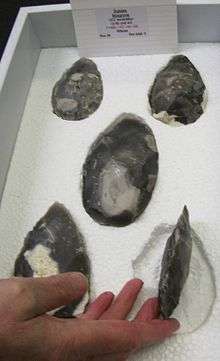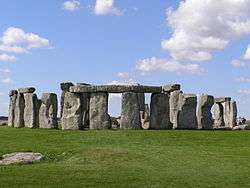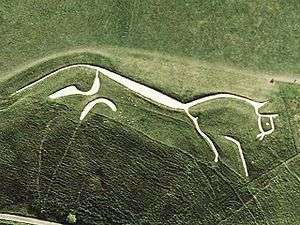Timeline of prehistoric Britain
| Other centuries |
| Prehistory | 1st century |
Events from the prehistory of Britain (to 1 BC).
Conventions
- This timeline focuses on species of Homo and covers the Pleistocene from the first evidence of humans.
- The names used for glaciations and interglacials are those with historic usage for Britain and may not reflect the full climate detail of modern studies.
- Dates for the Paleolithic are given as Before Present (BP), which uses 1 January 1950 as the commencement date of the age scale. All later dates are given as Before Christ (BC), which uses the conventional Gregorian calendar with AD 1 as the commencement date of the age scale.
Events
Paleolithic

A selection of stone tools from Eartham Pit, Boxgrove
- 970,000 to 936,000 BP
- Paleolithic flint tools at Happisburgh. The earliest known evidence of Homo sp. in Britain, presumed to be Homo antecessor.[1][2]
- 700,000 BP
- Flints tools at Pakefield. Possibly a cross between Homo antecessor and Homo heidelbergensis.[3][4][5][6][7]
- 500,000 BP
- Remains of Homo heidelbergensis at Eartham Pit, Boxgrove. The earliest human remains found in Britain.[8]
- 478,000 BP
- Anglian Glaciation begins - the most extreme glaciation in the Pleistocene. Britain almost completely under ice.
- 450,000 BP
- The Weald-Artois Anticline breaks for the first time after a glacial lake outburst flood. This landbridge to the continent was cut for the first time creating the English Channel. It would now reflood after every glaciation ended.[9]
- 425,000 BP
- Hoxnian Interglacial begins as the Anglian glaciation ends.
- 400,000 BP
- Bones of a young female Neanderthal (Homo neanderthalensis) at Swanscombe Heritage Park. Earliest evidence of Neanderthals in Britain.[10]
- 352,000 BP
- Wolstonian Glaciation begins. Neanderthal occupation intermittent.
- 180,000 BP
- Neanderthals completely driven out. There will be no human occupation of any kind for many thousands of years.
- 160,000 BP
- A second megaflood widens the break in the Weald-Artois Anticline.[9]
- 130,000 BP
- Ipswichian Interglacial begins.
- 125,000 BP
- Rising sea-levels cut Britain off completely from the continent. It is warm enough for hippos in the Thames and lions on the site of Trafalgar Square, but Neanderthals did not cross the landbridge in time so there are no Homo sp. present.[11]
- 115,000 BP
- Devensian Glaciation ('Last Glacial Period') begins.
- 60,000 BP
- Sea levels have dropped sufficiently for Neanderthals to return to Britain in the warmer periods, possibly only as summer visitors.[11]
- 44,000-41,000 BP
- Jawbone from Kents Cavern. First evidence of modern humans (Homo sapiens) in Britain.[12][13]
- 40,000 BP
- Neanderthals go extinct across Europe.
- 26,000-13,000 BP
- Dimlington stadial[14] ('Last Glacial Maximum'). Britain almost entirely under ice. Southern England a polar desert. Humans driven out.
- 16,500-14,670 BP
- Windermere interstadial[15] (the 'Allerød oscillation' or 'Late Glacial Interstadial'). Temperatures rise. Homo sapiens returns to Britain.
- 12,890-11,700 BP
- Loch Lomond stadial[16] ('Younger Dryas'). Temperatures drop rapidly. Humans driven out.
- 11,700 BP
- The Holocene warming begins as the end of the Younger Dryas stadial ends the Pleistocene. The first Mesolithic people arrived and this marks the start of continuous human (Homo sapiens only) occupation.
Mesolithic
The upper body of the Cheddar Man a Mesolithic skeleton.
- c. 9335–9275 BC
- c. 7600 BC
- Howick house, Northumberland, a Mesolithic building with stone tools, nut shells and bone fragments.
- c. 7150 BC
- Cheddar Man, the oldest complete human skeleton in Britain
- c. 6500-6200 BC
- Rising sea-levels cause the flooding of Doggerland. The culminating tsunami caused by the Storegga Slide, cuts Great Britain off from the continent.
- c. 6000 BC
- c. 4600-3065 BC
- Date range of artefacts from a Mesolithic midden on Oronsay, Inner Hebrides, giving evidence of diet.
Neolithic

Stonehenge, a neolithic stone monument constructed from 3000 BC to 2000 BC.
- c. 4000 BC
- Neolithic period begins in Britain, introducing the first agriculture.[19]
- c. 3500 BC
- Garth tsunami impacts the Northern Isles.[20]
- c. 3000 BC
- c. 2600 BC
- Main phase of construction at Stonehenge begins, replacing earlier wooden and earthen works.
- c. 2300 BC
- Arrival of the Beaker People in Britain, replacing 90% of the earlier population.[21][19]
Bronze Age

The Uffington White Horse, a Bronze Age hill figure.
- c. 1800 BC
- Wessex culture brings bronze-working to Britain.[19]
- c. 1600 BC
- Last construction at Stonehenge.
- c. 1400 BC
- Wessex culture replaced by more agrarian peoples; stone circles and early hillforts produced.[19]
- c. 1380-550 BC
- Uffington White Horse hill figure cut in Oxfordshire.
Iron Age
.jpg)
Old Oswestry, an Iron Age hillfort
- c. 800 BC
- Celts bring iron working to Britain; Hallstatt Culture.[19]
- c. 400 BC
- c. 330 BC
- Pytheas of Massilia circumnavigates Britain.[19]
- c. 300 BC
- c. 100 BC
- First wave of Belgic invaders settle in the south-east, establishing the Catuvellauni and Trinovantes tribes.[19]
- First coins introduced.[19]
- c. 80 BC
- 55 BC
- 54 BC
- July – Julius Caesar invades Britain and defeats the Catuvellauni under Cassivellaunus.[19]
- September – Tribute fixed, and peace agreed between the Catevellauni and the Trinovantes, allied with Rome. Romans return to Gaul.[19]
- 50 BC
- 34 BC
- c. 25 BC
- Tincommius, leader of the Atrebates, issues Roman-style coinage.[19]
gollark: Ah, but their ships themselves would have to be weapons to travel interstellarly.
gollark: Technologically speaking.
gollark: What? Basically everything can be reapplied as weaponry somehow.
gollark: Any aliens capable of crossing interstellar distances to get to Earth can almost certainly deal with the asteroid thing.
gollark: The bits which *were* observation-based and empirical got moved into their own sciences.
See also
References
- Miriam Frankel. "Early Britons could cope with cold : Nature News". Nature.com. Retrieved 13 November 2012.
- Parfitt, Simon A.; Ashton, Nick M.; Lewis, Simon G.; Abel, Richard L.; Coope, G. Russell; Field, Mike H.; Gale, Rowena; Hoare, Peter G.; Larkin, Nigel R.; Lewis, Mark D.; Karloukovski, Vassil; Maher, Barbara A.; Peglar, Sylvia M.; Preece, Richard C.; Whittaker, John E.; Stringer, Chris B. (2010). "Early Pleistocene human occupation at the edge of the boreal zone in northwest Europe". Nature. 466 (7303): 229–233. Bibcode:2010Natur.466..229P. doi:10.1038/nature09117. PMID 20613840.
- Parfitt.S et al (2005) 'The earliest record of human activity in northern Europe', Nature 438 pp.1008-1012, 2005-12-15. Retrieved 2011-04-16.
- Roebroeks.W (2005) 'Archaeology: life on the Costa del Cromer', Nature 438 pp.921-922, 2005-12-15. Retrieved 2011-04-16.
- Parfitt.S et al (2006) '700,000 years old: found in Pakefield', British Archaeology, January/February 2006. Retrieved 2008-12-24.
- Good. C & Plouviez. J (2007) The Archaeology of the Suffolk Coast Archived 8 March 2012 at the Wayback Machine Suffolk County Council Archaeological Service [online]. Retrieved 2009-11-28.
- Tools unlock secrets of early man, BBC news website, 2005-12-14. Retrieved 2011-04-15.
- "500000 BC - Boxgrove". Current Archaeology. 24 May 2007. Retrieved 23 April 2019.
- Gupta, Sanjeev; Jenny S. Collier; Andy Palmer-Felgate; Graeme Potter (2007). "Catastrophic flooding origin of shelf valley systems in the English Channel". Nature. 448 (7151): 342–345. Bibcode:2007Natur.448..342G. doi:10.1038/nature06018. PMID 17637667. Lay summary – NBC News (2007-07-18).
- Hendry, Lisa (15 December 2017). "First Britons". Natural History Museum. Archived from the original on 4 August 2018. Retrieved 17 April 2019.
- Greenhalgh, Tate; Hendry, Lisa. "The making of an island". Natural History Museum. Retrieved 2019-12-30.
- Higham, T; Compton, T; Stringer, C; Jacobi, R; Shapiro, B; Trinkaus, E; Chandler, B; Groening, F; Collins, C; Hillson, S; O'Higgins, P; FitzGerald, C; Fagan, M (2011), "The earliest evidence for anatomically modern humans in northwestern Europe", Nature, 479 (7374): 521–524, Bibcode:2011Natur.479..521H, doi:10.1038/nature10484, PMID 22048314
- "Fossil Teeth Put Humans in Europe Earlier Than Thought". The New York Times. 2 November 2011.
- Rose, James (1985). "The Dimlington Stadial Dimlington Chronozone – A proposal for naming the main glacial episode of the Late Devensian in Britain". Boreas. 14 (3): 225–230. doi:10.1111/j.1502-3885.1985.tb00724.x.
- Pennington, W. (1977). "The Late Devensian flora and vegetation of Britain". Biological Sciences. Philosophical Transactions of the Royal Society. Series B. 280: 247–271.
- Gray, J.M.; Lowe, J.J. (1977). "The Scottish Lateglacial Environment: a synthesis.". In Gray, J.M.; Lowe, J.J. (eds.). Studies in the Scottish Late-GlacialEnvironment. Oxford: Pergammon Press. pp. 163–181.
- Milner, Nicky; Conneller, Chantal; Taylor, Barry, eds. (2018). Star Carr: Volume 1: A Persistent Place in a Changing World. York: White Rose University Press. ISBN 978-1-912482-04-7.CS1 maint: ref=harv (link)
- Balter, Michael. "DNA recovered from underwater British site may rewrite history of farming in Europe". Science. Retrieved 16 March 2015.
- Palmer, Alan & Veronica (1992). The Chronology of British History. London: Century Ltd. pp. 13–16. ISBN 0-7126-5616-2.
- Bondevik, Stein; Mangerud, Jan; Dawson, Sue; Dawson, Alastair; Lohne, Øystein (1 August 2005). "Evidence for three North Sea tsunamis at the Shetland Islands between 8000 and 1500 years ago". Quaternary Science Reviews. 24 (14): 1757–1775. doi:10.1016/j.quascirev.2004.10.018. hdl:1956/735. ISSN 0277-3791.
- Olalde, Iñigo; et al. (2017). "The Beaker Phenomenon And The Genomic Transformation Of Northwest Europe". bioRxiv 10.1101/135962.
This article is issued from Wikipedia. The text is licensed under Creative Commons - Attribution - Sharealike. Additional terms may apply for the media files.